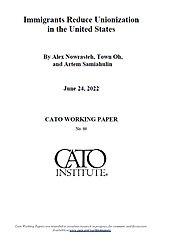Immigrants Reduce Unionization in the United States
We find that immigration explains a sizable portion of the decline in unionization in the United States.
Since the 1960s, U.S. union density has consistently dropped as the immigrant share of the population has risen. Using the Naylor and Cripps (1993) model of union formation, we argue that immigrants reduce unionization because they have lower preferences for unionization and increase diversity in the working population that, in turn, decreases solidarity among workers. Empirically, we employ the skill‐cell method devised by Borjas (2003) over the 1980–2020 period. We find that immigration reduced union density by 5.7 percentage points between 1980 and 2020, which accounts for 29.7 percent of the overall decline in union density during that period.

